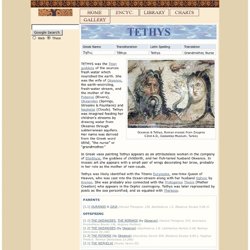

Undine (alchemy) Undines (from Latin: Unda "a wave"), also called ondines, are water elementals in alchemical works of Paracelsus.[1]

List of Mythical Creatures. The Hindu Pantheon. Beryl. In geology, beryl is a mineral composed of beryllium aluminium cyclosilicate with the chemical formula Be3Al2(SiO3)6.

The hexagonal crystals of beryl may be very small or range to several meters in size. Terminated crystals are relatively rare. Pure beryl is colorless, but it is frequently tinted by impurities; possible colors are green, blue, yellow, red, and white. Etymology[edit] The name beryl is derived (via Latin: beryllus, Old French: beryl, and Middle English: beril) from Greek βήρυλλος beryllos which referred to a "precious blue-green color-of-sea-water stone";[1] from Sanskrit vaidúrya(वैदुर्यः): "brought from Vidûra" (originally lapis lazuli) [4] akin to Prakrit verulia, veluriya ("beryl").[5] The German word brille (eyeglasses) is also derived from Sanskrit vaidurya.[6] The term was later adopted for the mineral beryl more exclusively.[2] Deposits[edit] Varieties[edit] About Aquamarine. Getting to know about gem "Aquamarine" Aquamarine general information The name Aquamarine is derived from two Latin words: aqua, meaning “water” and marina, meaning “of the sea.”

In the beryl species, aquamarine is second only to emerald in popularity. Fine aquamarines are paired with diamonds and mounted in platinum in this jewelry suite. In the commercial market, aquamarine competes with treated blue topaz for attention, but fine aquamarine sells for far more than equivalent-quality treated blue topaz. Aquamarine’s hardness and transparency make it popular with designers, artists, and carvers.
Aquamarine’s color range is very narrow. Although sapphire is the most popular blue gemstone, aquamarine is one of many other blue stones that have considerable markets of their own. Color causing element in Aquamarine Like peridot, aquamarine's color caused by the traces of iron in its crystal structure combined with two charge transfer. Cutting of aquamarine: Aquamarine' clarity Heat treatment: Tethys (mythology) In Greek mythology , ( Ancient Greek : Τηθύς ), daughter of Uranus and Gaia [ 1 ] was an archaic Titaness and aquatic sea goddess , invoked in classical Greek poetry, but not venerated in cult. TETHYS : Greek Titan goddess of fresh water & nursing ; mythology ; pictures : THETYS.
TETHYS was the Titan goddess of the sources fresh water which nourished the earth.

She was the wife of Okeanos , the earth-encircling, fresh-water stream, and the mother of the Potamoi (Rivers), Okeanides (Springs, Streams & Fountains) and Nephelai (Clouds). Tethys was imagined feeding her children's streams by drawing water from Okeanos through subterranean aquifers. Her name was derived from the Greek word , "the nurse" or "grandmother. " In Greek vase painting Tethys appears as an attributeless woman in the company of Eileithyia , the goddess of childbirth, and her fish-tailed husband Okeanos. In mosaic art she appears with a small pair of wings decorating her brow, probably in her role as the mother of rain-couds.
THEOI GREEK MYTHOLOGY, Exploring Mythology & the Greek Gods in Classical Literature & Art. The Greek Pantheon. The Faery Tradition. Ancient Egyptian religion. Ancient Egyptian religion was a complex system of polytheistic beliefs and rituals which were an integral part of ancient Egyptian society.

It centered on the Egyptians' interaction with many deities who were believed to be present in, and in control of, the forces and elements of nature. The practices of Egyptian religion were efforts to provide for the gods and gain their favor. Formal religious practice centered on the pharaoh, the king of Egypt. The Egyptian Deities.
The Celtic Pantheon. The Norse Pantheon. The Roman Pantheon. Salacia (mythology) In ancient Roman mythology , was the female divinity of the sea, worshipped as the goddess of salt water who presided over the depths of the ocean [ 1 ] .

She was the wife and queen of Neptune , god of the sea and water [ 2 ] . That Salacia was the wife of Neptune is implied by Varro [ 3 ] , and is positively affirmed by Seneca, Augustine and Servius [ 4 ] [ 5 ] . The god Neptune wanted to marry Salacia, but she was in great awe of her distinguished suitor, and to preserve her virginity, with grace and celerity she managed to glide out of his sight, and hid from him in the Atlantic Ocean.
The grieving Neptune sent a dolphin to look for her and persuade the fair nymph to come back and share his throne. Venus (mythology) Venus on seashell, from the Casa di Venus, Pompei. Before 79 AD. ( / ˈ v i . n ə s / , Classical Latin: / ˈ w ɛ . n ʊ s / ) is the Roman goddess whose functions encompassed love, beauty, sex , fertility, prosperity and victory. Emerald. Etymology[edit] The word "Emerald" is derived (via Old French: Esmeraude and Middle English: Emeraude), from Vulgar Latin: Esmaralda/Esmaraldus, a variant of Latin Smaragdus, which originated in Greek: σμάραγδος (smaragdos; "green gem").[3] Properties determining value[edit] Cut emeralds.

Emerald - Gemsquares. The Roman Pantheon. The Welsh Pantheon. The Welsh Pantheon.